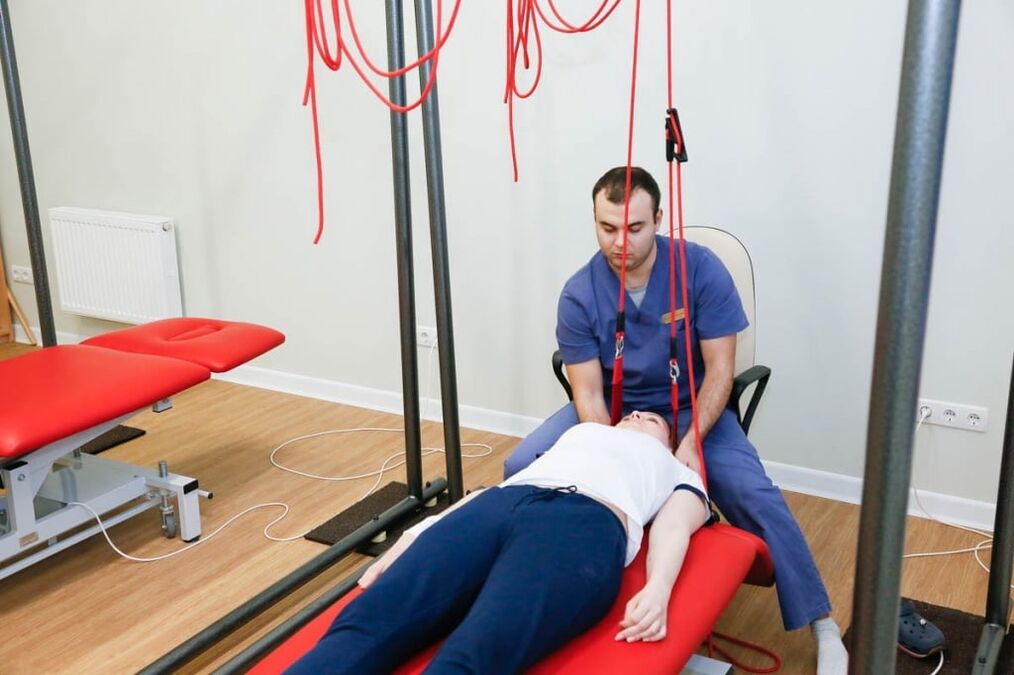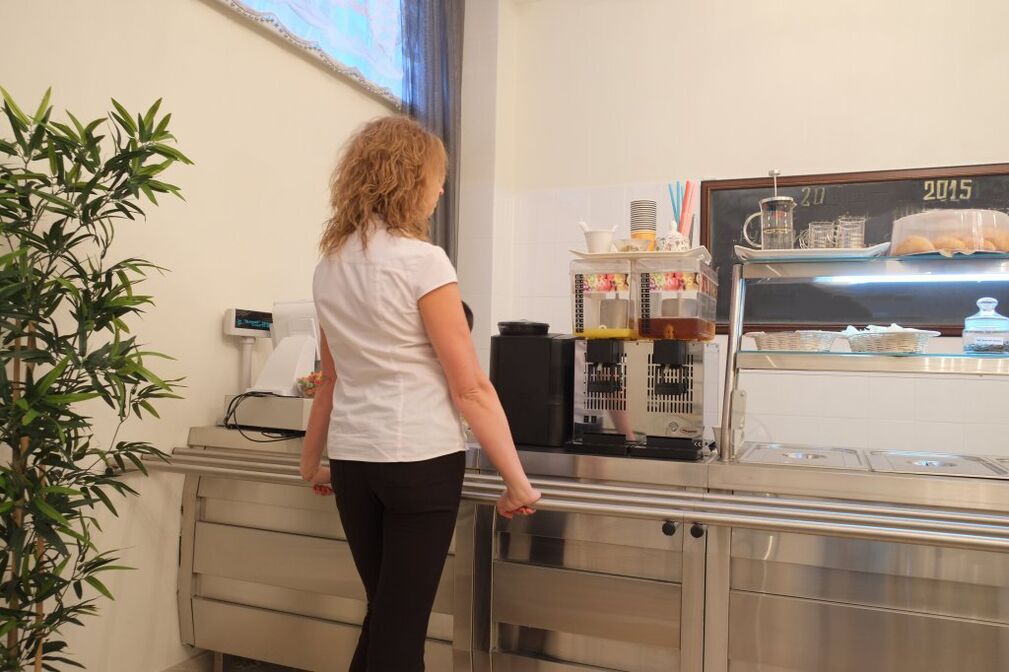Cervical osteochondrosis is a disease in which the vertebrae and intervertebral discs are affected. Osteochondrosis of the cervix refers to deformities of the doses. Evolutionary changes in the discs have already been observed at the age of 20. At the same time, they become more sensitive to loads, less elastic and lose lubricating fluid.
Most often, the pathology occurs in the elderly, but at present there is a significant increase in the incidence between children and adolescents. Neurologists are diagnosing osteochondrosis of the cervix using the latest diagnostic studies. Once the diagnosis is clarified, the complex treatment is performed with the most effective drugs, physiotherapy procedures and innovative methods of physical rehabilitation.
The name of the disease consists of two Greek terms "bones" (bone) and "cartilage" (cartilage). Osteochondrosis of the cervix begins with changes in the central part of the disc. The intervertebral disc loses moisture, decreases in size, this leads to the convergence of the vertebral bodies and violation of the nerve roots with the vessels. The vertebrae receive nutrients from the surrounding tissues, which is harmful to the body. Compression of the nerves and blood vessels leads to protective muscle spasm, which, as the disease progresses, becomes the cause of pain.

Which doctor treats this disease
The treatment of osteochondrosis is the field of activity of neurologists. However, when symptoms of osteochondrosis of the throat appear, it is possible to consult a general practitioner. A neurologist will select medications for osteochondrosis of the cervix that have the least stress on the body, which is important for medication.
To determine the presence of a pathological process in the cartilage tissue and osteochondrosis of the cervix, the patient is referred for a comprehensive examination. Tactics for treating cervical osteochondrosis are being developed according to research findings.
Interdisciplinary collaboration also allows the patient to have comorbidity treatment. In addition, the patient receives full information support: a treatment plan, an excerpt on the cost of services, the provision of information on specialist consultation and diagnostic measures.
Causes
Osteochondrosis of the cervix develops under the influence of various causative factors. No specific cause of cervical osteochondrosis has been identified. The disease is often associated with metabolic disorders and aging of the vertebrae.
Researchers suggest that cervical osteochondrosis develops for the following reasons:
- Excessive stress on the spine. A high load on the spine is observed when wearing the wrong shoes, flat feet, obesity, prolonged sitting position.
- Metabolic disorders. Deficiency of vitamins, minerals, disorders of calcium metabolism can serve as a cause of degenerative processes in the vertebrae.
- Congenital and acquired abnormalities of the spine and ligament (thickening of the ligaments, back pain, sacrilege)
- Pathologies of the gastrointestinal tract, leading to insufficient absorption of nutrients.
- Infection, poisoning?
- Injuries, bruises, fractures of the spine, as a result of which the blood supply and hydration of the spine are interrupted, which causes their dystrophic disorders.
- Stress;
- He wears shoes with heels.
- Pregnancy, especially multiple pregnancies.
- Autoimmune connective tissue damage, abnormal collagen structure types 1 and 2.
- Occupational hazards (lifting heavy loads, prolonged vibration, working in a sitting position with a constant head tilt).
- Atherosclerotic and other changes in the vertebral arteries.
- Curvature of the spine (kyphosis, scoliosis, cyclosis).
An important risk factor for the development of cervical osteochondrosis is the burden of heredity. This fact proves the presence of osteochondrosis in children, when the spine is not yet overloaded.
Degrees
Due to the special structure of the spine, it is able to perform its functions. The main building block is considered to be the Vertebral Motion Unit (VMS). It consists of two adjacent vertebrae, an intervertebral disc and a muscle-ligament device. Osteochondrosis leads to dystrophic degenerative processes, first in the intervertebral disc and then in the vertebra. With the defeat of a vertebra, the performance of its functions is provided by adjacent. This leads to an increase in the load and loss of mobility of the affected part.
In the development of cervical osteochondrosis, doctors distinguish several stages:
- The first degree of cervical osteochondrosis. As the intervertebral disc is deprived of its own blood supply and receives nutrients from the surrounding tissues, it undergoes degenerative changes. Osteochondrosis in the 1st stage of development is characterized by destruction of the nucleus accumbens and cracks in the fibrous ring. Clinically, this is manifested by acute or persistent local neck pain (cervicitis) and stiffness.
- Second degree osteochondrosis of the cervical spine. At this stage, the destruction of the fibrous ring continues, abnormal mobility and instability of the vertebrae appear. Patients complain of neck pain, aggravated by physical exercise, tilting the head or in a specific position.
- The third stage of the disease is characterized by complete destruction of the fibrous ring. The gelatinous nucleus is not stable. Itchy discs may appear and cause severe pain. At this stage, due to the poor fastening of the SMS, curvature of the spine may form.
- In the fourth stage of the disease, the intervertebral disc is replaced by connective tissue, other adjacent parts are affected. Spondyloarthritis, arachnoiditis develops. The joints become completely immobile - ankylosis develops. Bone tissue grows around the affected area - bone is formed. With the fourth degree of cervical osteochondrosis, there are strong symptoms: severe pain radiating to the arm, sternum, in the area between the shoulders, tenderness disorders.

Symptoms and signs
The signs of cervical osteochondrosis in the early stages may be non-specific: dizziness, headaches, weakness, injury during head movements. As the disease progresses, the following symptoms develop:
- Severe pain in the neck and shoulders
- Numbness of the hand
- Dizziness;
- Increased blood pressure
- Reduced coordination of movements.
- Increased sweating.
There are many syndromes that occur with the development of a pathological condition of the muscles of the back and cervix:
- Cervical migraine syndrome.
- Spinal artery syndrome.
- Hypertensive syndrome.
- Heart syndrome.
- Radical syndrome.
They occur when nerve endings are injured, arteries and veins are compressed as the disease progresses. The most dangerous complication is considered to be vertebral artery syndrome. There is a violation of blood flow through the artery that supplies the brain and spinal cord. The patient's hearing is reduced, vision is reduced, constant dizziness develops. The patient may lose consciousness while driving due to a sudden violation of blood flow.
As a result of the compression of the nerves that are responsible for hydrating the muscles of the chest and diaphragm, there is pain in the area of the heart, which is not associated with heart disease, but at the same time, tachycardia, arrhythmia and hypotension may develop. Compression of the veins leads to the development of hypertensive CSF syndrome. Intracranial pressure increases, nausea, vomiting and severe headache occur due to reduced blood flow from the brain.
As a result of compression of the neck, a radical syndrome develops - there is severe pain in the neck, shoulders, shoulders and back of the head. With this syndrome, the area of the arms and neck becomes numb. With cervical migraine syndrome, the patient is concerned about severe fibrous pain, which is often accompanied by nausea and vomiting.
Reflex syndromes occur when the roots of the spine have not yet been affected. Patients complain of pain in the neck, head (especially the back of the head), hands on one or both sides. Reflex pain, unlike radical pain, is not associated with sensitivity disorders. Cervicitis can be dull, painful. Severe sharp pain "lumbago" is called cervical. There is spasm and muscle pain, pain in the paravertebral points. The signs of cervical osteochondrosis intensify in an uncomfortable position, with tilting of the head, coughing, physical exercise. Signs of epicondylitis, uroscopic pericarditis and shoulder syndrome occur due to nerve impulses from the fibrous ring of the affected part, which causes compensatory muscle spasm.
Radical syndromes are accompanied by reduced motor activity and sensitivity. At the same time, the nerves, the blood vessels are weakened, the venous and lymphatic outflow in the pathological focus is disturbed as a result of the reduction of the intervertebral canal. The pain in the root syndrome is acute, intense. A common cause of spinal nerve entrapment is hernia formation. In the area of abnormal focus, muscle tone decreases. With radical ischemia, in addition to the nerves, the vessels are compressed.
If the phrenic nerve is involved in the pathological process, heart syndrome occurs. Manifested as burning, acute pain in the left side of the chest with radiation to the arm, the endoid area. The name of the syndrome is due to the fact that the nature of the pain is similar to an angina attack. The main difference between angina pain is that it is relieved after taking nitroglycerin, it can appear at rest and is combined with interruptions in heart rate (tachycardia, arrhythmia).
The signs of cervical osteochondrosis depend on the location of the pathological process. With damage to the upper cervical vertebrae, the blood supply to the brain is interrupted due to compression of the cerebral arteries. This leads to headaches (especially in the occipital region), dizziness, fainting, high blood pressure. Dizziness with cervical osteochondrosis is caused by reduced blood flow to the inner ear. Patients are also concerned about the onset of nausea, hallucinations and ocular symptoms.
With a combined lesion of the vertebrae, they talk about cervical osteochondrosis. The disease is manifested by the following symptoms:
- Dizziness;
- Pain in the neck and arm
- Tingling, creeping sensation in the upper extremity.
- Intermittent neuralgia.
Diagnostics
Osteochondrosis of the cervix is a chronic disease that can lead to hernia formation and compression of the spinal cord. Therefore, it is important to determine an accurate diagnosis in time and start treatment. The following types of diagnostic instruments are used to diagnose cervical osteochondrosis:
- Spine or x-ray of the spine. This research method is painless, highly informative and does not require special training. An x-ray of the spine allows you to assess its anatomical and functional features. In the picture, attention is paid to the structure of the vertebrae, their relationship to each other, the distance between them, the lumen of the spinal canal.
- Computed tomography - provides information mainly about the condition of bone tissue, allows you to detect a narrowing of the spinal canal and disc herniation.
- MRI - allows you to identify changes in soft tissues. The MRI image clearly shows changes in the intervertebral discs and spinal cord.

Drug treatment
The treatment of osteochondrosis of the cervical spine consists of pharmaceutical and non-pharmacological treatment. Even after complete treatment, neurologists take precautionary measures to rule out recurrences of the disease. In the acute period, for the treatment of osteochondrosis of the cervical spine, doctors prescribe drugs of the following pharmacological groups in patients:
- Non-narcotic analgesics. They are taken orally or injected intramuscularly to achieve a quick result.
- Non-steroidal anti-inflammatory drugs.
- B vitamins in large doses.
Diuretics are used to reduce fluid retention in the spinal cord and surrounding tissues. Antihistamines enhance the action of analgesics. Muscle spasms are eliminated with muscle relaxants. With prolonged severe pain syndrome, neurologists perform nerve block.
Chondroprotectors are used to improve metabolic processes in the intervertebral disc. These drugs increase the content of glycosaminoglycans, increase the stability, elasticity and absorption of vibrations of the intervertebral discs.
Dizziness pills
Patients often experience dizziness with cervical osteochondrosis. To reduce them, doctors prescribe non-steroidal anti-inflammatory drugs. NSAIDs belonging to different groups differ in mechanism of action and effect, therefore, only a qualified specialist can determine the appropriate drug.
It is important to remember that medicines for osteochondrosis of the cervical spine can not be taken without a doctor's appointment. Non-steroidal anti-inflammatory drugs have side effects, so before prescribing them, the neurologist determines the presence of contraindications in the patient and the required dosage. Medications for dizziness in cervical osteochondrosis can improve the patient's quality of life.
Injections for osteochondrosis
Injections for osteochondrosis of the cervix help relieve pain during flare-ups. With this method of drug administration, the effect appears quickly. Neurologists use a variety of injections.
Nurses inject medicinal solutions subcutaneously, intramuscularly or intravenously. During the period of exacerbation of the disease, drugs administered by injection, with osteochondrosis of the cervix, have a purely symptomatic effect.
Headache treatment
Headache is a symptom that occurs with various disorders. However, cervical osteochondrosis is characterized by periods of severe headache. Head movements increase the symptoms, so to eliminate them, doctors prescribe analgesic tablets and non-steroidal anti-inflammatory drugs.

Non-drug treatment methods
The complex non-drug treatment of cervical osteochondrosis of the spine includes:
- Protective function - when the roots are tightened, patients are on a hard surface,
- Massage;
- Physiotherapy exercises?
- Spinal traction?
- Physiotherapy procedures.
Massage for cervical osteochondrosis is used to reduce pain and swelling, improve peripheral blood supply and eliminate muscle spasm. A contraindication to performing this procedure is the presence of acute pain. Massage the neck and back in the direction of the lymph outflow. Particular attention is paid to the intracellular and paravertebral zones.
Therapeutic exercise for osteochondrosis of the cervical spine aims to eliminate muscle spasm and strengthen the muscular framework. As vertebral instability often occurs in the cervical spine, the exercise therapy instructor conducts individual lessons, during which he teaches the patient to perform the exercises safely. Some authors suggest taking physical therapy classes at Shants Collar
To improve the mobility of the cervical vertebrae, rehabilitation therapists recommend performing the following exercises:
- Bending and extension of the neck. Tilt your head forward towards your chest, without pulling your shoulders forward and then back. Hold the incline for 3 seconds, repeat each exercise 8-10 times.
- Curves of the neck. Turn your neck first to the left until it stops, then to the right, without changing the position of the shoulders and the level of the chin.
- Lower your head until it stops. Then tilt your head back without changing the level of your shoulders. Hold the position for 5 seconds.
The following exercises have been developed to strengthen the neck muscles:
- Place your hand on the back of your head. Tilt your head back, resting on your hand.
- Place your hand on the time zone. As you tilt your head, resist with your hand.
- Put your hand on your forehead, resisting it, tilt your head
- Tilt your head sideways with your right hand, with your left hand behind your back. Repeat the exercise on the other side.
Gravity therapy is the exact name of the process of pulling the spine. It is performed using special devices. The goal of treatment is to reduce muscle spasm and restore the correct position of the vertebrae. To avoid complications, the spine is pulled by a doctor.
The following physiotherapy procedures are used to improve the blood supply to the pathological focus, relieve swelling and eliminate pain:
- Dynamic currents. During this procedure, using a special device, low-frequency currents are applied, which stimulate the muscles, relieve spasms and pain. You have a positive effect, improving the nutritional tissue.
- Ultraviolet radiation. Under the influence of ultraviolet radiation, the metabolism of vitamin D improves, the calcium content increases, the bone tissue becomes stronger.
- Ultrasound exposure - used to speed up blood flow, antispasmodic and remedial action. Ultrasound can penetrate deep into the tissues, sometimes being used for better absorption of drugs.
- Amplipulse therapy - allows you to relieve pain by blocking nerve impulses from painful focusing.
In the acute period of the disease, which lasts 4-7 days, sedatives, antispasmodics, irritants are used to reduce pain. The patient has peace. Immobilization of the cervical spine is performed using the Shants collar. Exercise and massage are contraindicated. Apply ultraviolet radiation.
The duration of the subacute period is 29 days. After complete recovery, the patient should rest for several days. Then you can start a course of rehabilitation treatment. In the chronic course of the disease, the patient is prescribed muscle relaxants, chondroprotectors, B vitamins, for pain - analgesics, NSAIDs. Physiotherapy exercises, massage are provided. The patient is released physiotherapy procedures (proliferation, exposure to alternating current), becomes spinal traction.

Food
Proper nutrition for osteochondrosis is an important condition for achieving remission. The progression of cervical osteochondrosis is stopped with diet and treatment. Neurologists know how to treat osteochondrosis of the cervical spine, therefore, they are a complex of therapeutic measures, such as procedures, exercise therapy, proper nutrition and lifestyle changes.
Many patients ask neurologists how to treat osteochondrosis of the cervical spine and whether there are dietary restrictions. Specialists create individual diet plans that take into account the patient's preferences. The diet for osteochondrosis is based on a balanced, low-fat diet rich in nutrients. The patient's daily diet includes foods high in calcium.
How to sleep with cervical osteochondrosis
For patients with diseases of the musculoskeletal system, the question of how to sleep properly with cervical osteochondrosis. Sleeping on your stomach causes the disease to develop further, so it is best to avoid sleeping in this position. The best positions are at the back and side.
Osteochondrosis of the cervix develops while resting on a bed with a soft mattress. Therefore, experts suggest that you prefer elastic mattresses, as well as moderately soft pillows. If a patient is diagnosed with cervical osteochondrosis, experienced specialists will tell you which bed is safe to sleep on.
Prophylaxis
To prevent the onset or progression of cervical osteochondrosis, doctors recommend:
- Maintain the correct posture.
- Live an active lifestyle, take breaks from work.
- Do regular physical therapy exercises.
- Sleep on a firm, level surface, orthopedic mattress and pillow.
- Get rid of bad habits, especially smoking.
- Choose shoes taking into account the normal structure of the foot.
- Do not carry bags on one side, this will cause the spine to bend.
- Live a healthy lifestyle, eat right, eat lots of fruits and vegetables.
- He does not sit for a long time with his head tilted.
- I'm going for a swim.
In order to improve blood circulation, massage therapy should be performed regularly.






























